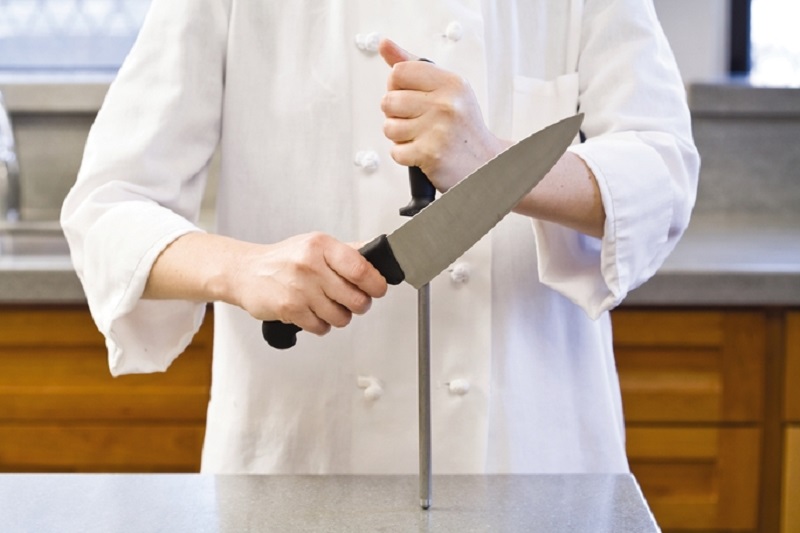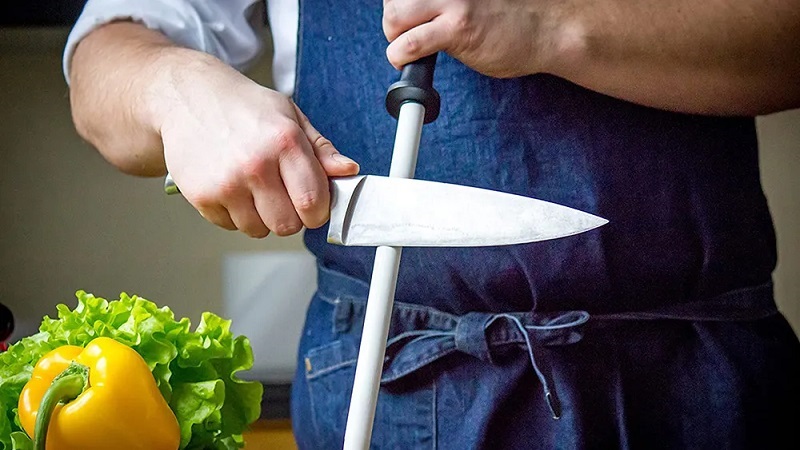A sufficiently sharp knife is one of the most essential tools in a cook’s arsenal. The length of time a knife’s blade stays sharp depends on several factors, including how it is stored, the type of cutting board (hint: avoid glass), and the type of knife itself (for instance, Japanese-style blades, frequently made of more rigid steel, can dull faster than softer German-style knives, which bend and warp). To keep your knives sharp for as long as possible, you must know when to hone or sharpen them. While maintaining a knife’s edge requires both honing and sharpening, their purposes are distinct.
Do Knife Sharpening Rods Work?

Yes, honing rods work, as any knife’s edge can get dull and distorted when frequently used. That makes honing and sharpening tools essential to keep your blades sharp and edgy.
And while a whetstone’s pressure will wear away some of the steel from your blade, creating a fresh, sharper edge, honing entails putting the knife down a honing rod an equal number of times on each side. The rod will keep your blades sharp, just like a toothbrush cleans your teeth. By using your honing rod and brushing your teeth, you can reduce the frequency of dental visits and the need to sharpen your knife. Using the correct knife sharpening rod for your knives maintains their edge sharpness and speeds up repairs by realigning the edge for a longer time.
The frequency of honing your knives will depend on how frequently you use them. Since chefs use their knives for more jobs than any home cook, they frequently sharpen them daily. By comparing the blade to its typical degree of sharpness, you can determine whether it’s time to sharpen it. Most experts advise a quick clean-down with steel wool before beginning any substantial meal preparation.
What’s the Ideal Material for a Honing Rod?

The three most popular types of honing materials available on the market are ceramic, diamond, and stainless steel. Each kind has advantages and disadvantages, so it’s not a one-size-fits-all deal. You should use the right kind of honing rod material based on the knives you use.
Not every rod works with every steel; your honing rod should be harsher than the knife steel for optimal results. “The wand chooses the wizard, Harry.” – that’s similar to how you pick rods for your knives. The high hardness of Japanese blades makes ceramic necessary, in contrast to the softness of German knives.
Ceramic steels (more precisely called ceramics) can remove a tiny bit of metal from your knives during the honing process, which shows up as grey streaks on the ceramic rod. In other words, they offer a moderate edge enhancement. But ceramic is gentle enough not to harm your blade permanently; thus, it’s a fantastic choice for regular honers who would rather delay a full sharpening as long as possible.
Other Important Considerations

Which honing steel is proper for you depends on your lifestyle, skill level with knives, and how often you cook. However, all suitable honing steels should possess a few universal features. A broad crossguard between the grip and the blade on excellent steel will keep your hand from unintentionally sliding down the steel.
One of the first things I consider while choosing a knife sharpening knife is its length. When honing longer knives, such as chef’s knives and slicers, a longer rod is essential since it allows you more room to manoeuvre the knife. When steeling smaller blades, such as paring knives, it’s not necessary. (It’s crucial to understand that because serrated knives have teeth, they are difficult to sharpen.)
It should be at least 30 centimetres long, as a general guideline. The knife won’t strike the work surface below because it is the length of the steel rod, not the handle. You may search for a longer rod if your blades are 25 cm or longer. But for the majority of us, 30 centimetres is adequate.
How to Use a Honing Rod in a Few Steps

You can maintain the sharpness of your blades by routinely sharpening them by following these easy steps.
- Take the knife by the handle in one hand and the steel in the other. Pointing up, both hands should be. They should form a simple inverted V shape as they come together.
- Press the blade’s heel on the steel approximately 2 cm from the tip. A 15° angle is the ideal setting for the knife concerning the steel. The tilt should be 20° for German and more oversized blades, and for Japanese or thinner knives, it should be 15°.
- Slide the knife down the steel and towards the blade’s tip using mild to medium pressure. Maintain the same angle between the blade and the steel by taking time. Speed is not as crucial as accuracy regarding knife honing.
- Do this once again on the other side of the knife blade with the same side of the steel. Keep switching sides for 5 to 10 strokes or until the edge is crisp.
- Your blade will be free of tiny steel fragments after you wash and dry it.
Extra Honing Tips
- Move only the knife and not the rod.
- you don’t want to scratch the knife; therefore, the steel should only come into contact with the knife’s edge. Take care when handling the steel so as not to cut your hands. Use a slow, steady stroke to ensure total control over the knife.
- It’s time to use a stone when honing is no longer effective.
